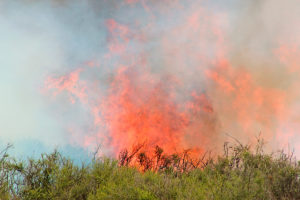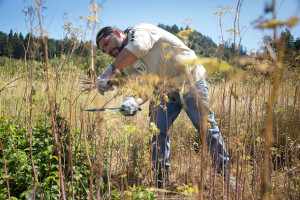Standing above her home perched on the north slope of Claremont Canyon along the Berkeley-Oakland border, Marilyn Goldhaber points across the valley. Most of the houses on the other side were damaged or razed in the massive 1991 wildfire that burned 1,520 acres and torched 3,500 homes and apartments.
Two decades later, residents are still trying to figure out how to deal with the reality of wildfire while also respecting and potentially restoring native habitats. While large agencies like the University of California and the East Bay Regional Park District develop massive fuels management policies, citizens on the ground have pursued efforts both to reduce the flammability of their neighborhoods and, in some instances, to restore the canyon’s native, fire-resilient habitats.
The largest group, the Claremont Canyon Conservancy, turns 10 years old this fall. It has drawn locals to support projects from eucalyptus removal to small-scale restoration. Meanwhile, another group, the Garber Park Stewards, has zeroed in on a 14-acre Oakland city park near the canyon bottom.
Restoring Claremont Canyon is turning out to be ecologically complex. The canyon is the largest and least-developed of the east-west canyons in the Berkeley hills. It retains substantial pockets of coastal scrub, oak/bay woodlands, maple forest, and riparian areas of willows and ferns. “This mosaic of vegetation is something we don’t generally see in the East Bay hills, especially in the fog belt,” says Lech Naumovich, director of the Golden Hour Restoration Institute.
As in many places, a big part of preventing another disastrous fire is dealing with built-up fuels from decades of fire suppression. The university and park district are handling the major fuel removal–occasionally with opposition from residents partial to eucalyptus trees, but more often with local support.
Changes on the ground have been remarkable, says Goldhaber: “A year ago you could not see behind my fence.” Claremont Canyon Regional Preserve was thick with scrub and nonnative broom. The park district recently cleared the area as defensible space. “That’s what everybody wants,” Goldhaber says, “a fire-safe defensible zone on both the neighbors’ side and the park side.” In 2006, the conservancy worked with the district to remove a nearby eucalyptus grove. Now Goldhaber tends the area, and natives such as monkeyflower, California everlasting, and bush lupine are coming back. “They’re rebounding everywhere,” she says.
Over on the canyon’s south side, the Garber Park Stewards are working to keep a swath of woodland and riparian habitat free of invasives.
Towering big-leaf maples, sprawling oaks and bays, and clusters of buckeyes define the park. There’s also a spring-fed riparian area carpeted in native horsetails. The stewards call this the horsetail meadow, but lurking underneath is a mat of invasive cape ivy that becomes visible when the horsetail dies back every year.
“Cape ivy is our worst enemy in this park,” says Shelagh Broderson, the Garber Park Stewards’ coordinator.
For years the park was so neglected that some neighbors didn’t even know it was a park. Others dumped garbage and yard clippings in it, and ivy ran rampant.
The conservancy provided early financial support, but the Garber Park Stewards are less interested in fuels reduction than in restoring a once-popular city park. Besides removing invasives and re-planting natives, the group has also uncovered and cleaned up a large, centrally located stone fireplace.
While its origins remain mysterious–volunteers have searched old newspaper archives and guess that the fireplace was built in the 1920s–it does prove that previous generations enjoyed visiting the canyon, maybe to relax in the forest’s dappled light.
Garber Park’s old stonework–built to last and built for fire–is perhaps a fitting symbol of the continuing dilemma of humans living in a fire-prone landscape. Two decades after the firestorm, some canyon residents are restoring native plants, others focus on defensible space, and along the way, one hopes, they achieve a balance that can endure.
Learn more at claremontcanyon.org and garberparkstewards.blogspot.com.

.jpg)



